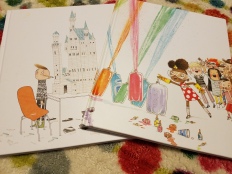
In my last post I talked about how picture books are great at cliff hangers–a device that’s also incredibly useful for novelists. But I’ve got more to say about how reading picture books can help novelists write better fiction.
In this week’s installment of how my son is helping me write better books, I’m talking about character and conflict. I know you know that a good novel needs clear conflict and characters with clear motivations and distinct personalities.
But did you know that picture books do this masterfully? It’s true! By the first page, sometimes the first sentence, pictures books have already established who the main character is, what they want, and what’s keeping them from getting it. And that’s exactly what novelists should do, too!
Be clear, and quickly!
A good writer is a clear writer, writing words that weave pictures in the reader’s imagination. But it takes a lot of hard work to write so clearly that the reader never pauses, wondering, “…what’s going on here?” Often, it means using fewer words, and making sure they’re the RIGHT words.
That’s why picture books are excellent examples of clear writing, writing that immediately and with no confusion introduces character, conflict, motivation, all those things that are essential to good storytelling. Genre dictates that they have less space, fewer words, to tell the story in. Every. Word. Matters. And every word must function to make the story crystal clear.
 Two picture books that do this particularly well are Iggy Peck, Architect and Ada Twist, Scientist, both by Andrea Beaty. We know right away who Iggy and Ada are and what drives them.
Two picture books that do this particularly well are Iggy Peck, Architect and Ada Twist, Scientist, both by Andrea Beaty. We know right away who Iggy and Ada are and what drives them.
From the first lines of Iggy Peck, we know Iggy is an architect and a talented one at that:
“Young Iggy Peck is an architect and has been since he was two, when he built a great tower–in only an hour–with nothing but diapers and glue.”
Every page and sentence after this illustrate’s Iggy’s talent and how it puts him in conflict with his world.
Similarly, from the first sentences of Ada Twist, we know the conflict and a character detail that keeps us reading to find out more:
“Ada Marie! Ada Marie! Said not a word till the day she turned three. She bounced in her crib and looked all around, observing the world but not making a sound.”
Every page and sentence after this develops Ada’s silent curiosity about the world, showing us how it gets her into trouble.
These books have fewer pages to fill and smaller attention spans to appeal to, so they must stay focused on the central conflict and on creating captivating characters that are crystal clear for young readers.
Now it’s the novelist’s turn!
 But aren’t novels more sophisticated than that? Yes, they are, in some ways. The sentence structure, the language, the plot, the characters themselves, the conflicts–all these things are more complicated and complex in adult fiction. But adult fiction still needs clear and immediate characterization and conflict in order to 1) hook the reader and 2) immerse the reader in the world of the book. If we can be immediate and clear with these things, like picture book writers are because they MUST be, then we have a better chance of hooking our adult readers.
But aren’t novels more sophisticated than that? Yes, they are, in some ways. The sentence structure, the language, the plot, the characters themselves, the conflicts–all these things are more complicated and complex in adult fiction. But adult fiction still needs clear and immediate characterization and conflict in order to 1) hook the reader and 2) immerse the reader in the world of the book. If we can be immediate and clear with these things, like picture book writers are because they MUST be, then we have a better chance of hooking our adult readers.
Here’s an exercise that will help you clarify conflict, character, and motivation for your reader as quickly as possible:
Turn your novel into a kid’s book.
No, seriously. Try it out! No matter what your content is–murder, sex, satire, politics–write the story as if you’re writing a 32-page picture book. You won’t actually give it to children … I mean … unless you stumble onto the PERFECT way to tell your story. But telling your novel’s story in picture book style will help you figure out which elements are the most crucial and so need to be introduced soonest.
So get ready, writers, you’re about to distill your 300+ pages into 32! And in the process, you’ll learn what REALLY MATTERS to your story.
First, zone in on the most important characters, conflicts, and goals in your novel. Then tell the story using those key ingrediants in 1500 words or less. Bonus points for making it rhyme!
You’ll notice that you have to get the most important elements in the very first sentences, or you don’t have room to expand on the conflict and resolve it. At the end of the exercise, you will have identified the most important parts of your novel and moved them to the front of the story.
When you return to your novel manuscript, revise with your picture book in mind, keeping those characters, conflicts, etc as close to the front as possible. See if you can introduce them as quickly in the novel as you did in the picture book.
If you can introduce all the major elements of your novel as quickly as a picture book can, you’ll hook those readers like a Dr. Seuss hooks a toddler!
And believe me, that’s impressive!
Have you ever tried writing a picture book? Give our exercise a try, and let us know how it goes!
